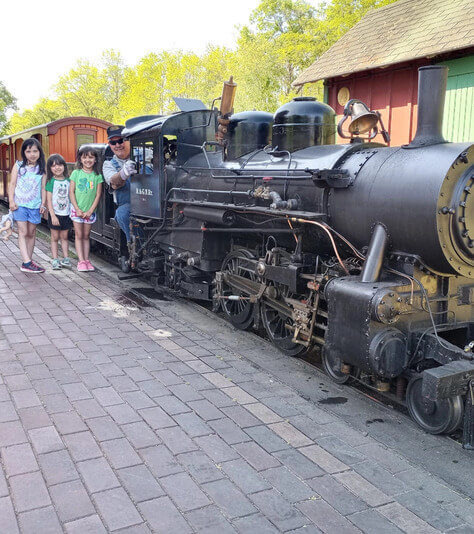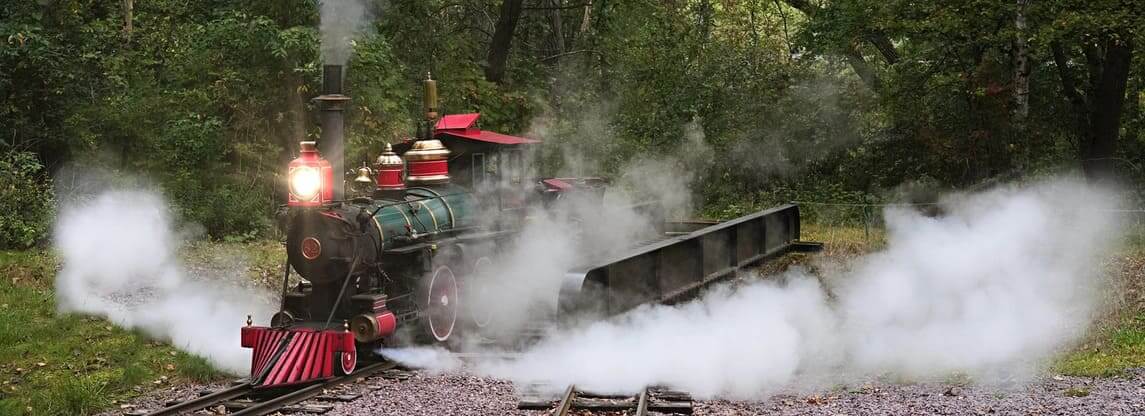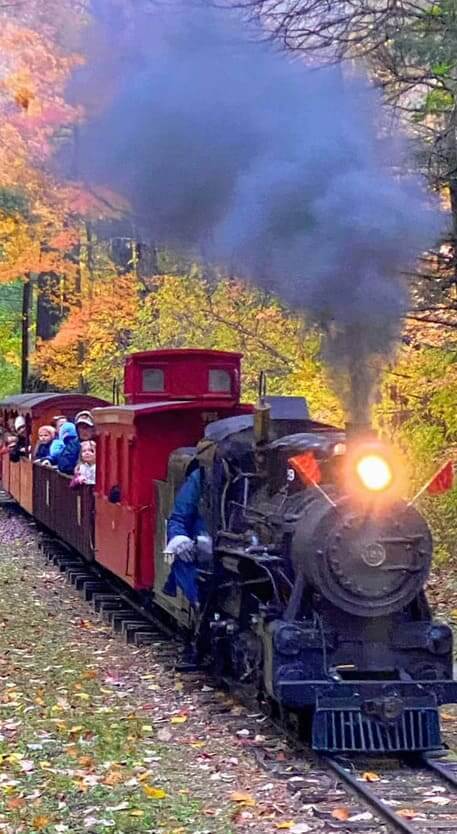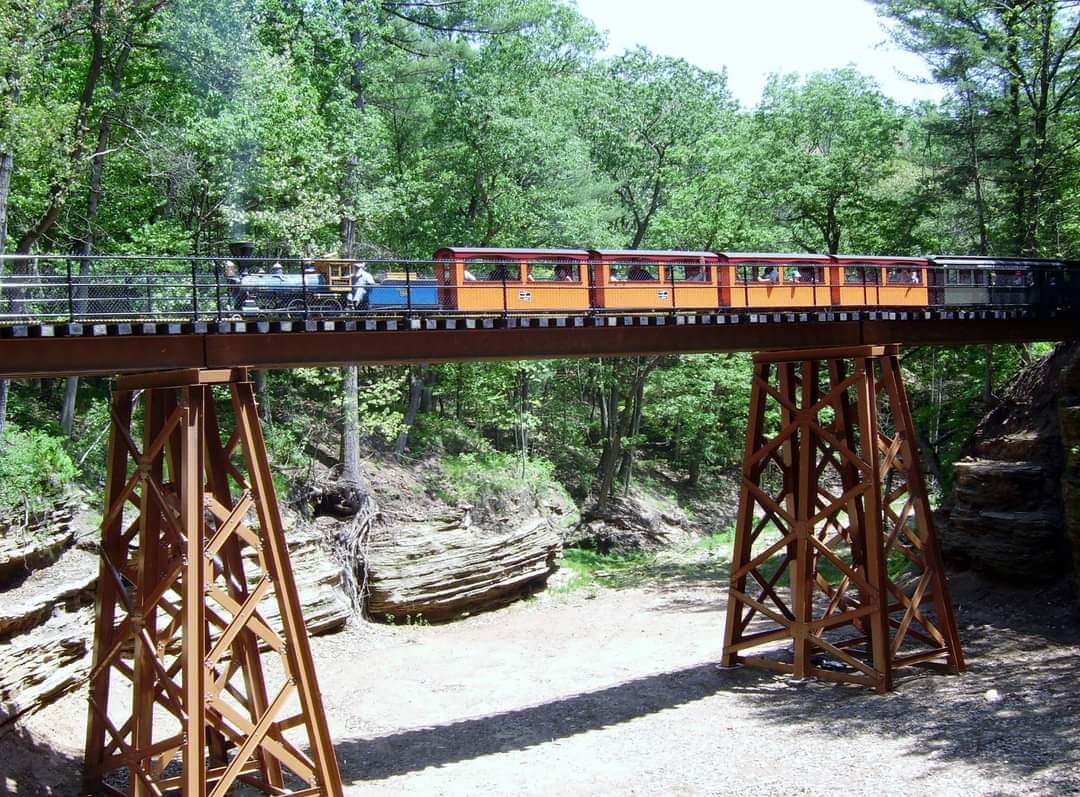Our Story

IT ALL STARTED IN JANESVILLE WISCONSIN
The Riverside & Great Northern Railway started in Janesville, Wisconsin in the late 1940s with Elmer Sandley saying to his son Norman, “If you’ll go with me, I’ll play ball with you and we’ll build a 15-inch-gauge railroad that would be big enough for everyone to enjoy” (“The Sandley Story” p. 30). City administrators approved a ten-year lease on a two-mile right-of-way along the Rock River from Riverside Park to Mercy Hospital. While the Sandleys built locomotives 4001, 128, Tom Thumb, and several passenger coaches in 1947-48, every hobbyist in the neighborhood came out to help lay track. At 11:00 a.m. on June 6, 1949, with four half-block-long lines of people waiting for a ride, Elmer Sandley departed South Park Station in Riverside Park at the throttle of locomotive 128 pulling the first train of fare-paying passengers.

Inspired by Sir Arthur Heywood, who coined the term “minimum gauge” in 1874 to describe the principle behind his Duffield Bank Railway in England, the Sandleys decided on 15-inch gauge track for their railway and established the Sandley Light Railway Equipment Works to manufacture trains that operate on tracks of that gauge. The Sandley’s business model was to promote the idea that authentic 15-inch gauge railways – and in particular steam-powered railways – could meet the needs of small U.S. communities and developing “third world” countries. Fifteen inches was considered the smallest gauge for a commercially successful railroad carrying people and products. The R&GN would be a demonstration railway for prospective buyers.

The “RGN – The Scenic Route to Riverside Park” was popular with many, but not all, the citizens of Janesville. After three years of neighbor complaints and the city’s unwillingness to renew the lease, between 1952-1955 the Sandleys moved the R&GN to Wisconsin Dells, laying tracks on a railroad roadbed that went back to 1857 when the La Crosse & Milwaukee Railroad built a standard gauge railroad through the area. Around 1896 the Chicago, Milwaukee, and St. Paul Railroad, which owned the right-of-way at the time, abandoned that stretch of roadbed because of the steep grade and moved the tracks a few hundred feet southwest, where they are today.
In 1952 the Sandleys purchased the abandoned right-of-way from the Milwaukee Road and laid down 15-inch gauge track on a one-and-a-half-mile, east/west route just off Stand Rock Road about a mile north of downtown Wisconsin Dells. On August 9, 1953, a golden spike ceremony took place to celebrate the opening of the R&GN for business as a steam railway tourist attraction and train manufacturing facility.
The Sandley’s philosophy of authentic steam railroading attracted several customers during the Dells years – although they were not small American communities or third world countries looking to establish inexpensive yet profitable commercial railways. The Sandleys built these railways for parks and private estates:
Lake Wales, Great Masterpiece & Southern Railway – Phantom Grove Express — Lake Wales, Florida Hoot-Toot & Whistle Railway — Elgin, Illinois Milwaukee County Zoo Railway — Milwaukee, Wisconsin Ampersand Reset South Eastern Railway — Lake Forest, Illinois Stet & Query Central Railway — Lake Forest, Illinois Quinsippi Central Railway – The “Little Q” — Quincy, Illinois Brookfield, Salt Creek & Western Railroad – the Zoo Line — Brookfield Zoo Chicago, Illinois Knoxville Zoo Railway — Knoxville, Tennessee
The Sandley Works also built other non-railroad steam-related items, most notably a steam truck and a rebuilt engine for the Apollo steamboat that operated on the Wisconsin River near Wisconsin Dells.
Unfortunately, due to circumstances in the 1970s, the Sandley Light Railway Equipment Works filed for bankruptcy in 1981. However, fans of Sandley-built trains and the R&GN railway established the Riverside & Great Northern Preservation Society to assume the mortgage and management of the R&GN as a living museum tourist attraction.
The Society was activated on July 15, 1988. Because 1980 was the last season the R&GN had operated under Sandley management, nature had taken over the railway, so volunteers spent most of 1988-89 getting the railway ready for operation again. During that time the Society was able to work out a deal with the Milwaukee County Zoo to lease steam locomotive no. 82, which the zoo no longer used in regular service, and finish three 12-person passenger coaches in time for a grand reopening on May 15, 1990.
Several Sandley-built locomotives and rolling stock have returned to the R&GN over the years, but with the R&GN Society’s purpose to “demonstrate the design, development, operation, and maintenance of steam railways,” other locomotives and rolling stock continue to be added to the roster.

The R&GN Preservation Society’s early years:
In 1988 volunteers led by William C. Fitt formed the Riverside & Great Northern Preservation Society, Inc. and went to work to restore the R&GN railway. During 1988 and much of 1989, bolstered by volunteers from the Milwaukee Light Engineering Society and The Chippewa Valley Railroad, the Society restored a mile of roadbed, replacing over 5,000 ties, and returned buildings on the property to operating condition.
On October 21, 1989, the Riverside & Great Northern Railway returned to operating status as Norman Sandley opened the throttle of 82 and took a train of donors, contributors, and volunteers in Sandley Works–built gondolas on the mile-long trip to the end of the refurbished railroad. During the winter of 1989/1990 Society volunteers went to work repairing Sandley passenger cars and extending the track to the end of the main line. On May 15, 1990 – the 36th anniversary of the first passenger train to operate on the Riverside & Great Northern Railway – the R&GN reopened as a living museum in a ceremony headlined by Ronald Fiedler, Secretary of the Wisconsin Department of Transportation.
The Riverside & Great Northern has had its highlights and lowlights. In the early years the Society often was just barely able to pay the bills, and as is always the case with organizations owned and operated by volunteer members, some haven’t always agreed with others as the Society sorted out a path to the future.
The R&GN has had its share of disasters, too. On July 2, 1995, a fire started around midnight on the outside of the Boiler Shop near the turntable. Fortunately, the Wisconsin Dells Fire Department responded quickly and a Society member who was spending the night on the premises had 15 years of experience in a volunteer fire department and was able to provide information he knew would be valuable in putting out the fire. After a series of heavy rainstorms in 2004, the fill at Riverside Canyon washed away as water flooded through the canyon. With assistance from government and private resources a trestle bridge was built in 2005-06 to connect the mainline again. In 2018 after several days of heavy rain, the roadbed washed out in three places at mileposts 5, 13 “Shelf,” and 21. Government assistance provided funding to repair the line.
The Riverside & Great Northern is a living museum. As George Broad said in the May 1994 edition of ModelTec magazine:
“Walking through the R&GN’s yards, one simply cannot escape the feeling of reality that is there. This is not a tourist attraction, with the rolling stock stored in Quonset huts behind false-front building. Here is a railroad, lifted out of time. It is as real as walking through the Rio Grand’s yards at Chama, or perhaps the Sandy River’s at Phillips, many, many years ago. All the facilities any railroad might need are there: a five-stall roundhouse; a 30’ turntable; car, locomotive, and boiler shops and sheds. The track layout is cramped, linear and utilitarian. It is real.”
Behind the doors of the railway buildings, the work of maintaining and operating the railroad goes on. Through thick and thin, the Riverside & Great Northern Railway has endured, grown, and developed over the years since a small group of volunteers formed the Riverside & Great Northern Railway Preservation Society, Inc. The strength of the Society has been in its members, who donate thousands of hours of work to the museum every year, allowing the museum to live on as “a railroad, lifted out of time.”


